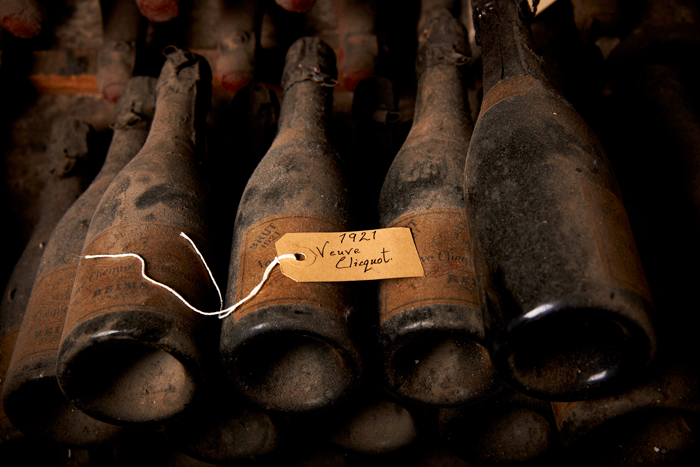All I want for Christmas is…
Author: Demetri Walters MW
When our chairman recently encouraged me to jump out of an aeroplane at 12,500 feet, I began to consider an ideal-world scenario in which my lawyers insisted on a vinous compensation package furnished entirely by the Berry Bros. & Rudd family reserves that slumber peacefully beneath No.3 St James’s Street. Each of the following bottles has risen from the family cellars and played their part over a lunch or dinner at which I have been lucky enough to be present, and conjure up happy memories of fellowship and good living – ideal wines then for Christmas Day.
From time to time we are privileged enough to open a half-bottle of 1921 Veuve Clicquot as a pre-prandial sharpener. This hugely complex weave from one of the best inter-war Champagne vintages, with not a bubble in sight, is best refreshed with a non-vintage from the same house; guests are invariably staggered at how delicious the resulting cocktail is. From experience I know this goes very well with smoked salmon. I hope that, years hence, a successor will enjoy the same experience with a mature English sparkling wine.
To lunch: as a lover of seafood I am convinced of the versatility of Chablis, it being one of the best-value wines out there (even at the Grand Cru end of the scale). I don’t know of any restaurants that serve 1923 Chablis Grand Cru, Vaudésir, Lupé-Cholet, but I have savoured it here with crab bisque. No longer Chablis in flavour, the wine is more like a concentrated nut elixir, yet delicious all the same. How can something this venerable taste so ethereal?
Classic wines don’t only hail from the Old World, nor come much more classic than Penfold’s 1982 Grange Hermitage. Simon Berry kindly entertained all of our Masters of Wine at lunch earlier in the year and, between him and Jasper Morris MW, set us blind tastings throughout the meal. This wine was served fully specified – it could not have been otherwise, as this vintage exemplifies the balance, concentration, and fruit intensity that are the hallmarks of this perennially excellent Australian when it reaches maturity and goes perfectly with almost anything on the big day: turkey, chipolatas, ham… even bread sauce.
Once in a while we get to taste something really extraordinary, a true vestige of a bygone age. The 1870 Ch. Margaux was one of those end-of-an-era wines that preceded the devastation of Bordeaux’s vineyards by phylloxera between 1875 and 1892. I remember the concentration of this wine being a wondrous thing. It was surprisingly spritely for such an old lady. I often stare at the now-empty olive-green bottle on my desk, made perfect by imperfections in the glass and the pretty fluting to its neck. This would be my sipper, in favour of Grange as the drinker, during the main course.
Sweet wine is one of my great passions; steamed puddings are up there too. I have a Greek-Cypriot mother who, having exchanged Eastern Mediterranean sunshine for the frequent gloom of these islands in 1958, agreed to learn how to make nursery puddings to suit the taste of my father and their three nascent sons. So, with my ‘boiled-baby’ and treacle I would delight in the lusciousness of 1868 Tokaji Essence, Bretzenheim, which, like so many wines at my fantasy dinner table, would have been bottled and cellared here at No.3. This unfathomably complex wine boasted around 600 grams per litre of residual sugar and only two to three percent alcohol, all poised by Tokaji’s legendary acidity and freshness. Having remained in stasis, it resembled a more layered version of contemporary vintages of Essencia, so not old at all. When, if ever, might I enjoy its like again?
Mature Port, together with cheese, is one of the true joys of Christmas. Working where I do, and possessing a predilection for wines that approach oblivion at a shuffle, I have been fortunate to enjoy some spectacular vintage Ports. 1927 Fonseca springs to mind as the first seriously good Port that I ever savoured, and I can still taste its fruit, forever young. Vintage Ports are rarely bought by the ‘pipe’ these days; we prefer to drink across a variety of houses and vintages. The greatest treat of all is the tingle of anticipation as you decide, often after many years of ignoring its existence, to exhume a much loved bottle from your cellar, settle it, open it and decant it, to drink it with family and friends. Now it’s time for us to enjoy a walk, or preferably a snooze, before we start all over again at supper. A happy Christmas to you all.



